



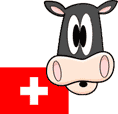
The main tourist destination of the Bernese Oberland is named Top of Europe. It is comprised of a railway station located inside the Mönch Mountain with a complex located outside above the glacier at an elevation of 11,300 feet. Unless you wish to hike and risk your life climbing the Eiger (total climbing deaths now stand at 62) you will need to take three railways starting with the Berner Oberland Bahn (BOB), change to the  Wengernalpbahn (WAB), and finally change to the Jungfraubahn (JB) to reach the Top of Europe. The WAB's route is completely rack operated with a gauge of 800 millimetres (2 feet 7 1/2 inches). It shares the Lauterbrunnen station with the BOB, climbs up to Kleine Scheidegg where it shares a station with the JB, descends down to Grund then climbs up once more to reach Grindelwald where it shares a station once again with the BOB. Changing trains is relatively painless and just requires walking across the stations platform. The scenery along the route is spectacular, providing you travel during sunny days! Departing from Interlaken Ost (East) and travelling to the Top of Europe takes about 2 1/4 hours.
Wengernalpbahn (WAB), and finally change to the Jungfraubahn (JB) to reach the Top of Europe. The WAB's route is completely rack operated with a gauge of 800 millimetres (2 feet 7 1/2 inches). It shares the Lauterbrunnen station with the BOB, climbs up to Kleine Scheidegg where it shares a station with the JB, descends down to Grund then climbs up once more to reach Grindelwald where it shares a station once again with the BOB. Changing trains is relatively painless and just requires walking across the stations platform. The scenery along the route is spectacular, providing you travel during sunny days! Departing from Interlaken Ost (East) and travelling to the Top of Europe takes about 2 1/4 hours.
 The Wengernalpbahn (WAB) is owned by Jungfraubahn Holding AG, a holding company that also owns the Jungfrau Bahn (JB) and the Bergbahn Lauterbrunnen Mürren (BLM). Through that holding company it is part of the Allianz Jungfrau Top of Europe marketing alliance, which also includes the separately owned Berner Oberland Bahn (BOB) and Schynige Platte Bahn (SPB). The Jungfrau Railway Group is a leading tourist company and the most important mountain railway company in Switzerland. Jungfraujoch - Top of Europe is the most profitable segment of the group with more than 800,000 annual visitors to the Top of Europe.
The Wengernalpbahn (WAB) is owned by Jungfraubahn Holding AG, a holding company that also owns the Jungfrau Bahn (JB) and the Bergbahn Lauterbrunnen Mürren (BLM). Through that holding company it is part of the Allianz Jungfrau Top of Europe marketing alliance, which also includes the separately owned Berner Oberland Bahn (BOB) and Schynige Platte Bahn (SPB). The Jungfrau Railway Group is a leading tourist company and the most important mountain railway company in Switzerland. Jungfraujoch - Top of Europe is the most profitable segment of the group with more than 800,000 annual visitors to the Top of Europe.
In 1890, Leo Heer-Betrix gained an 80 year concession to build and operate the Wengernalpbahn. Construction work commenced in 1891 laying 800 millimetre (2 feet 7 1/2 inches) track utilizing the Riggenbach rack system. (Today Strub rack is in use.) The following year the first steam locomotive reached Wengen on 18 Apr 1892 then the summit at Kleine Scheidegg on 10 Aug 1892. The completed line from Lauterbrunnen to Grindelwald which opened on 20 Jun 1893 as a summer only service is 19.091 kilometres (11.863 miles) long.
Electrification of the line between Lauterbrunnen and Kleine Scheidegg was completed on 3 Jun 1909 using 1,500 Volt DC with electric locomotives positioned, for safety reasons, at the lower end of the trains. The section between Kleine Scheidegg and Grindelwald followed on 24 Jun 1910. By 1912 all steam service had ceased.
The original line between Lauterbrunnen and Wengen, completed in 1892, was bypassed with the construction of a new line. On the 7 Jul 1910, the new line, longer but less steep, was opened between Lauterbrunnen and Wengen. The older route was retained for nearly a hundred years until finally being decommissioned and dismantled in 2009 because of the steep 25 percent gradient and a geological security risk.
 Winter operations commenced between Lauterbrunnen and Kleine Scheidegg in 1913 followed by year round operations over the same section in 1925. Winter operations between Grindelwald and Kleine Scheidegg started in 1934, followed by year round operations in 1960.
Winter operations commenced between Lauterbrunnen and Kleine Scheidegg in 1913 followed by year round operations over the same section in 1925. Winter operations between Grindelwald and Kleine Scheidegg started in 1934, followed by year round operations in 1960.
In 1942, the headquarters of the railway moved from Zurich to Interlaken. In 1947 the first motor cars (triebwagen) were purchased. The following year a partly underground turning wye at Kleine Scheidegg was constructed.
In 1990, an avalanche shelter was built on the Lauterbrunnen side of the operation, whilst in 1995 Wengen station was rebuilt to include a freight delivery terminal. In 2005, Wengernalp station platforms were extended from 127 metres to 181 metres usable length. In 2011 a new double track siding was opened between Wengen and Allmend allowing the introduction of regular timetable operation between Lauterbrunnen and Kleine Scheidegg.
Nowadays, most passenger trains are made up of railcars, the powered car still being positioned at the lower end of the train so train consists do not usually cross Kleine Scheidegg travelling directly from Lauterbrunnen to Grindelwald. However, the wye at Kleine Scheidegg allows a train to be turned if necessary so that it can also be used on the other side of the summit. The newest of these trains can reach 28 km/h on the steepest stretch.
The busiest stretch of railway runs from Lauterbrunnen to Wengen as this is also used to transport goods to car-free Wengen.
The railway maintains workshops at Lauterbrunnen and Grund - Wikipedia.

The earliest railcars still in service, number 101 and 102 (Class BDeh4/4, built by Schweizerische Lokomotiv und Maschinenfabrik (SLM) and Brown Boveri & Cie (BBC) date from 1947, Number 102 was refurbished 1985. The other 14 cars in this class, number 104 and numbers 106 to 118, were built between 1954 and 1964 and still survive. Ten have been refurbished (except 104, 7, 9, and 10) since 2000. Number 114 was refurbished along with 102 in 1985 but was returned to the workshop in 2002 to be brought up to the newer specifications.
In 1970 a new class of railcar, the BDeh4/4, was introduced, numbered 119 to 124, built by a consortium of Schweizerische Industrie Gesellschaft (SIG), SLM, BBC, and Societe Anonyme des Ateliers de Secheron (SAAS). These were refurbished in 1998. Four further cars, class BDhe4/8, numbered 131 to 134, and built by SLM with electrical equipment by BBC, arrived in 1988. In 2004 a series of four Stadler built Class Bhe4/8 panorama trains went into service.
The renewal of WAB rolling stock is part of a recent project. In total, six three-section panorama trains were ordered for CHF42 million. By autumn 2015, the commissioning of all panorama trains on the route from Lauterbrunnen to Kleine Scheidegg will take place.
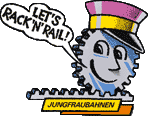 The photographs with this article were taken in 2009 and 2015. Back in 2009 I rode what might be called the Jungfrau Loop. Starting in Interlaken Ost (East) one takes the Berner Oberland Bahn (BOB) train to Zweilütschinen. This is a junction where the train splits in two. (Do any of you remember Canadian Pacific Railway's "The Canadian" splitting in Sudbury?) The BOB leading cars turn east towards Grindelwald while the second section continues on to Lauterbrunnen. As an aside, it's amusing here too, to watch the tourists get confused as to which part of the train they should be occupying when they reach Zweilütschinen. One couple heading for Interlaken got off the train expecting to board another only to watch their train leave them standing on the platform. Not to worry, the trains run about every half hour.
The photographs with this article were taken in 2009 and 2015. Back in 2009 I rode what might be called the Jungfrau Loop. Starting in Interlaken Ost (East) one takes the Berner Oberland Bahn (BOB) train to Zweilütschinen. This is a junction where the train splits in two. (Do any of you remember Canadian Pacific Railway's "The Canadian" splitting in Sudbury?) The BOB leading cars turn east towards Grindelwald while the second section continues on to Lauterbrunnen. As an aside, it's amusing here too, to watch the tourists get confused as to which part of the train they should be occupying when they reach Zweilütschinen. One couple heading for Interlaken got off the train expecting to board another only to watch their train leave them standing on the platform. Not to worry, the trains run about every half hour.
Zweilütschinen station is near the confluence of the Lütschine River with its two tributaries, the Weise (White) Lütschine and the Schwarze (Black) Lütschine, hence tha name Zweilütschinen, or Two Lütschine. Legend tells of how the two tributaries were named. Villagers who lived along the Weise Lütschine claimed that those who lived by the Schwarze Lütschine were so dirty it turned the river black. Villages who lived along the Schwarze Lütschine said those who lived by the Weise Lütschine never washed so that tibutary remained perfectly white.
Upon reaching Lauterbrunnen one simply crosses the covered platform to board a Wengernalpbahn train. This train climbs out of the Lauterbrunnen valley past Wengen to the railway summit station at Kleine Scheidegg, elevation 6,762 feet, but that's only about half way to the Top of Europe. Next, walk around the station and board a Jungfrau Bahn train which will take you to a station named Jungfraujoch blasted out of solid granite inside the Mönch mountain at 11,300 feet. Walk outside to enjoy the cold air and other attractions then return down to Kleine Scheidegg for the next leg on another Wengernalpbahn train, this time bound downgrade for Grindelwald. At Grindelwald you once again change trains by boarding the BOB for the final leg back to Zweilütschinen, wait momentarily for the Lauterbrunnen train to couple up, and in ten minutes your back at Interlaken Ost. Now that was in 2009 and the same trip is still possible today but you may find newer rolling stock in use. I don't recall the total cost of the trip, it was expensive, but hey, a visit to the Top of Europe is a once-in-a-lifetime event.
Fast forward to 2015. This trip was carried out by using an SBB Swiss Rail pass to get around Switzerland. The BOB, WAB, and JB are all private railways so one wouldn't expect to find them included in a SBB National rail pass. However, there are three pleasant exceptions. Firstly the SBB pass is valid on the BOB along its entire route. So you can travel between Interlaken Ost, Lauterbrunnen, Grindelwald, and all points in between. Secondly, and this seems odd, the Wengernalpbahn will let you use the SBB pass between Lauterbrunnen and Wengen. The remainder of the route you must pay a fare. Wengen is a car-free village with the railway providing the only reliable transport so perhaps this is why it's included in the SBB pass. As a result of this oddity no photos were taken in 2015 between Wengen and Grund. Thirdly, the SBB pass is also valid on the Bergbahn Lauterbrunnen Mürren (BLM), which connects at Lauterbrunnen, but that's fodder for another article which you may see here later.
To access Grund the BOB provided the transport then I walked downhill, a steep hill too, from Grindelwald to Grund to take photos. The thought of hiking back up to Grindelwald seemed onerous until I remembered the SBB pass was valid on Swiss buses. Catching a local bus in Grund avoided the long hike back up to Grindelwald.
25 Mar 2009 - Definitive Operating Permit Exists
13 Aug 2009 - Steep Path Disappears After 116 Years
4 Feb 2011 - Collision on the Wengernalpbahn
20 Jun 2013 - The Wengernalpbahn Celebrates its 120th Birthday
28 Jun 2013 - Street Crossing at Dorfstrasse
23 Sep 2014 - The New Pride of the WAB
17 Dec 2014 - Inauguration of the New Wengernalpbahn Panoramic Train
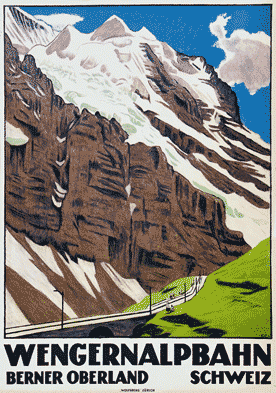
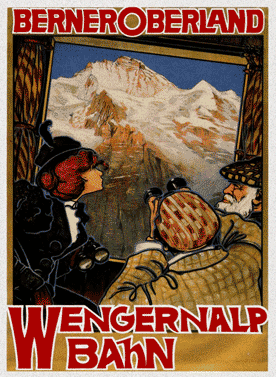
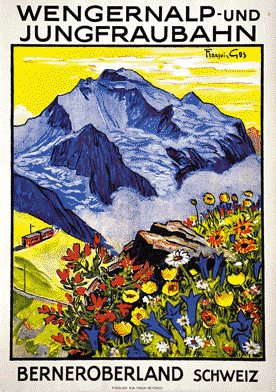
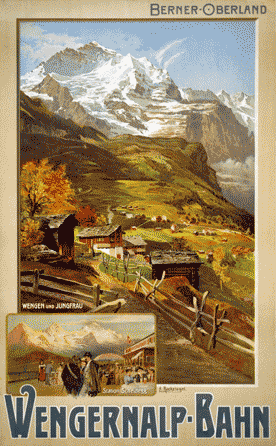
Wengernalpbahn (WAB)
Eingestellte Bahnen der Schweiz (photos of the abandoned line)
X-Rail Wengernalpbahn
Railfan Europe Picture Gallery
YouTube Video
Berner Oberland Bahn (BOB)
Jungfrau Bahn (JB)
Stadler
Gangloff AG (Link fails)

